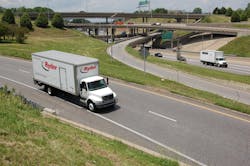A variety of current and “on-the-horizon” technologies will significantly improve the safety footprint of light vehicles and heavy commercial trucks in the near term, but the biggest – and still not fully utilized – safety enhancer remains telematics system, in the eyes of several experts.
“New vehicle safety technologies, such as lane keeping systems and active cruise control can often take up to three decades to fully encompass the vehicle population,” Chris Hayes, second VP for transportation risk control at the Travelers insurance firm, told Fleet Owner.
“We will see safety improvements from such technologies but not dramatic change; it takes time to see them fully implemented into cars and trucks,” he said.
“Telematics on the other hand now provides very detailed, objective data on the primary vehicle safety control system: the driver,” Hayes stressed. “Simply in terms of what technologies are available today, right now, to improve vehicle and fleet safety, telematics is the biggest game changer.”
Travelers hosted a vehicle technology safety symposium at its claims university campus in Hartford, CT earlier this month, where experts from Ford Motor Co., the Insurance Institute for Highway Safety (IIHS) and the Virginia Tech Transportation Institute (VTTI) discussed how new systems could impact driver safety as well as the future of vehicle insurance.
“The way we think about vehicles and driving may rapidly change in the next five years because of a host of current and emerging technologies being deployed in the automotive industry,” Daniel Brown, technical manager for risk control at Travelers, told Fleet Owner.
“Take one safety technology, for instance: forward collision warning combined with active braking,” he explained. “The NSC [National Safety Council] noted recently that nearly half of all fatalities and injuries from all types of vehicle crashes involve rear-end collisions. So now you have a technology that, if it can’t eliminate the rear-end crash, can at least reduce the severity of it by reducing vehicle speed at time of impact.”
Yet he feels the safety as well as the operational benefits offered by telematics offer the biggest near-term rewards for both everyday motorists and freight-hauling fleets alike.
“There’s still untapped potential for telematics in terms of safety,” Brown emphasized. “What I really like to tell people is that safety is all about the driver behavior; only to a small degree is weather and roadway design a factor.”
Yet the reason why telematics remains an “untapped” safety benefit to his mind is that fleets largely focus on the driving data such technology generates to identify “bad” drivers, rather than help their “good” drivers become even better.
“For decades, we really didn’t have a way to get information on how people actually drive; telematics has changed all that,” he said. “Just telling someone to ‘drive safe’ is almost meaningless without specifics. Now we can actually show each driver how they currently operate their vehicles and what they can specifically do to operate them better.”
Travelers’ Hayes stressed, though, that such “driver feedback” is almost more critical for a fleet’s best drivers – and is most effectively shared in a positive reinforcement setting.
“If you say, ‘Look, you are among our top 100 drivers for fuel economy, on-time delivery, and speed, but you’ve got a higher-than-average amount of hard braking,’ that changes the dynamics of the conversation,” he said. “Most drivers are actually shocked when they compare how they think they drive to how they actually do drive, and if you use that information as a tool to reward them for what they do well, it will stick.”
Insurers themselves are recognizing the safety benefits of telematics to the point where they are offering discounts for such technology. The Hartford, for one, recently announced it would offer a 5% discount on insurance premiums on its commercial auto premiums for fleets using telematics system.
Travelers’ Brown adds that using telematics data in this fashion not just all about lowering a fleet’s risk profile or gaining insurance premium discounts.
“The real benefit is for the driver; not only do you make them safer, but especially in the case of a crash, they can prove they were doing the right things,” he noted. “Once you show commercial drivers, especially, that the data will help them, you’ll get support for wider use of telematics in this fashion.”
About the Author
Sean Kilcarr
Editor in Chief
Sean Kilcarr is a former longtime FleetOwner senior editor who wrote for the publication from 2000 to 2018. He served as editor-in-chief from 2017 to 2018.
